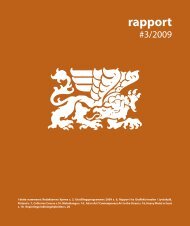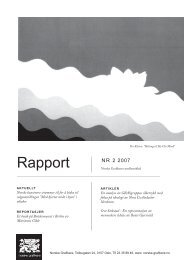Rapport nr. 3+4 2010-straight.indd - Norske Grafikere
Rapport nr. 3+4 2010-straight.indd - Norske Grafikere
Rapport nr. 3+4 2010-straight.indd - Norske Grafikere
You also want an ePaper? Increase the reach of your titles
YUMPU automatically turns print PDFs into web optimized ePapers that Google loves.
Fig. 4 R.M. Installation View White on White,<br />
multiple screenprints, 87 x 380 cm, 2003,<br />
Galerie Zement, Frankfurt<br />
repetitions of autographic marks. The hallucinatory<br />
and kinaesthetic effect achieved<br />
through this repetition seeks to mirror the<br />
function of spectacular commodity fetishism<br />
at the same time as calling into play<br />
the haptic qualities traditionally associated<br />
with the facture, the painted or drawn<br />
mark, of traditional aesthetics.<br />
I now turn to a discussion of the installation<br />
of my exhibition. How do the discursive<br />
and the factual/material intersect<br />
at the level of the work, the space and the<br />
viewer? What cultural modes of signification<br />
are cited or performatively enacted?<br />
Fig. 5 R.M. Installation View Grey on Grey, multiple screenprints,<br />
overall dimensions ca. 261x304 cm, 2003, Galerie Zement,<br />
Frankfurt<br />
My chosen exhibition space was the Galerie<br />
Zement in Frankfurt. A former industrial<br />
print workshop, this space is now<br />
used as a studio by a painter and an animator<br />
who also both organize and curate<br />
the exhibitions. The space is on these occasions<br />
turned into a gallery. Unlike in their<br />
earlier phase in the 1970s, when artist-run<br />
spaces constituted a crucial element in the<br />
institutional critique and commodification<br />
of art, they now have to function in<br />
a more competitive, enterprise-oriented<br />
environment for artists. Today – despite<br />
their differences – such spaces continue to<br />
provide a semi-institutional framework,<br />
especially for younger artists, to establish a<br />
‘position’, to gain the necessary experience<br />
and to win potential critical notice for further<br />
‘career opportunities’. As an institutional<br />
and architectural formation, some<br />
such spaces exist as a hybrid between the<br />
studio/workshop and the conventional<br />
modernist gallery, or ‘white cube’, a term<br />
which will be discussed in more detail<br />
later. In light of the ambiguous and temporary<br />
character of such artist-run spaces,<br />
the notion of performativity seems especially<br />
apt.<br />
As already indicated, every work of art can<br />
be considered performative – what Davey,<br />
in reference to Heidegger, calls its ‘eventual’<br />
character. But performativity understood<br />
in a more narrow sense is an inbuilt<br />
feature of my work. Prints function potentially<br />
as conventional ‘pictures’, hung in<br />
frames on the wall. Mine are mainly conceived<br />
as multiples or as a series specifically<br />
designed to derive their appearance<br />
from the chosen site. Since minimalism,<br />
installation refers to ‘a four-fold relational<br />
dynamic between objects, their surrounding<br />
space, its architectural frame, and the<br />
body of the viewer, in which architectural<br />
form [is] a given parameter of the exercise<br />
(even when violated)’. 7<br />
The ‘site specificity’ of installation to which<br />
Peter Osborne refers in the quote above is<br />
applicable to the gallery/workshop of the<br />
Galerie Zement with its particular architectural<br />
features and discursivity. This is<br />
a narrower reading of the term as is often<br />
currently the case. Instead of site specificity<br />
as pertaining to a specific physical location,<br />
it now more usually implies work<br />
that occupies a broadly cultural space,<br />
such as a shopping mall or other public<br />
location (Kwon, 1997, pp.85-110).<br />
Fig. 6 R.M. Grey on Grey, detail, transference effect Fig. 7 R.M. Grey on Grey, detail, front view Fig. 8 R.M. Virtual 9, detail, screenprint on nine perspex panels,<br />
overall dimensions ca. 71 x 71 x 240 cm, 2003<br />
In the case of the Galerie Zement, sitespecificity<br />
entailed the successful negotiation<br />
between the workshop aspects and<br />
the gallery elements to ‘stage’ a semblance<br />
of the codings of the white cube. Brian<br />
O’Doherty’s term for the modernist gallery<br />
space, has, especially since the publication<br />
of his essays on ‘The Ideology of<br />
the Gallery Space’ in 1986, stood as a critical<br />
shorthand to denote the reactionary<br />
exclusivity of art in its pristine confines<br />
(O’Doherty, 2000). While it promises<br />
transcendence from the outside world, the<br />
white cube as gallery space ultimately disguises<br />
its commercial nature. As indicated<br />
previously, other forms of ‘accreditation’<br />
have supplemented and, in some respects,<br />
replaced the gallery space, but the white<br />
cube – notwithstanding its many variations<br />
– remains. O’Doherty’s erstwhile critique<br />
has been subsequently revised. Daniel<br />
Birnbaum, director of the Städelschule<br />
and Portikus Gallery in Frankfurt, stated<br />
in 2001 that the white cube ‘can be seen<br />
as a structure of inclusion’ rather than exclusion<br />
(Birnbaum, 2001, pp.187-93). This<br />
seems wholly apposite, as the assumption<br />
of the exclusivity of the gallery space and<br />
the work therein appears to be based on a<br />
falsely modernist assumption that art can<br />
ever be ‘exclusive’ of cultural context.<br />
Unlike most galleries, the physical characteristics<br />
of the workshop at Zement<br />
collided with the subtlety of the prints<br />
themselves. The work, therefore, could be<br />
said to demand the features and rhetoric<br />
of the white cube. All the elements, such<br />
as heavy electronic surface wiring, rough<br />
and dirty stonework, and two rows of<br />
striking heating pipes, conspired to create<br />
a form of visual noise. Instead of treating<br />
this visual noise merely as a disturbance,<br />
a performative hitch, the major interruptions<br />
were eliminated. Gaps in the stonework<br />
were filled in and/or painted over<br />
and so on. The prints were then displayed<br />
in such a way as to articulate certain ‘noise’<br />
factors. For example, the horizontal line of<br />
surface wiring on the upper part of a wall,<br />
ending two-thirds along the wall, was used<br />
as the reference point for the format of the<br />
work White on White. (Figure 4)<br />
This series of single sheets consisted of a<br />
particular set of multiple repetitions of<br />
the ‘original’ marks that form the basis<br />
of all my work. The particular pattern of<br />
White on White was, as the title suggests,<br />
printed in subtle white and off-white<br />
tones, arranged in a vertical, continuous<br />
row. The sheets were hung flush with the<br />
wall, following its line to floor level and<br />
then extended in a rectangular angle out<br />
onto the floor into the space. The uppermost<br />
horizontal edge of the sheets paralleled<br />
the wiring above it. Its right-hand<br />
top corner was aligned with the wiring<br />
where the cable disappeared into the wall.<br />
The disturbance of the wiring was integrated,<br />
yet it also conflicted with the work.<br />
Similarly, two rows of strikingly shaped<br />
grey heating pipes – in the form of discs<br />
around a central pipe – both accentuated<br />
and disturbed the display of Grey on Grey.<br />
This large wall piece (with a surface area<br />
of 261 cm in width and 304 cm in length)<br />
consisted of twelve repeat sheets and was<br />
printed with a similar yet different pattern<br />
from White on White. Aligned at its upper<br />
boundary with a pipe running below the<br />
ceiling, the sheets adhered to the wall and<br />
then loosely curved around the back of the<br />
pipes to emerge underneath them into the<br />
floor space. (Figure 5)<br />
Noise as excess of information – in the more<br />
general sense – is commented upon by Mark<br />
C. Taylor (2000) in his book The Moment<br />
of Complexity, Emerging Network Culture:<br />
‘Noise, it is instructive to note, derives from<br />
the Latin word ‘nausea’, which originally<br />
meant seasickness. When information becomes<br />
the noise that engenders nausea, differences<br />
and oppositions that once seemed<br />
to fix the world and make it secure become<br />
unstable. Lines of separation become permeable<br />
membranes where transgression<br />
is not only possible but unavoidable.… As<br />
these polarities (between order – disorder,<br />
organization – disorganization, form –<br />
chaos) slip and slide, they eventually reverse<br />
themselves to disclose the spectre of dynamics<br />
that appear to be fluid’ (Taylor, 2000,<br />
pp.100-101).<br />
In the exhibition space at the Galerie Zement<br />
the two architectural and spatial<br />
codings – or polarities – ‘slip and slide’.<br />
The workspace with its affiliated connotations<br />
of honesty, reality and workmanship<br />
conflicted with the supposedly neutral<br />
white cube with its affinity with the spectacle.<br />
One could argue that the citational<br />
articulation of these codings through the<br />
work only re-enacts or performs ‘capitalism’s<br />
destabilizing, destructive dynamic<br />
of dispersal and dissolution’ (Potts, 2001,<br />
p.16). Yet, I would counter this assessment<br />
with the argument that it is precisely the<br />
task of art to make such operations visible.<br />
The codings of the white cube which differentiate<br />
the gallery space from ordinary<br />
architecture then become the key to mark<br />
this citation as a citation. Alex Potts in his<br />
study on the historical continuities between<br />
sculpture and installation has said:<br />
Fig. 9 R.M. Virtual 9, installation view, screenprint<br />
on nine perspex panels<br />
‘[…] if installation is architecture, it is another<br />
kind of architecture from the one we<br />
experience on a day-to-day basis … . Installation<br />
isolates and condenses particular<br />
architectonic shapings of space and then artificially<br />
stages these so one attends to them<br />
in a qualitatively different way from the architectural<br />
interiors one normally inhabits<br />
…’ (Potts, 2001, p.17).8<br />
How does the citational quality, the placing<br />
and character of the work, affect the<br />
viewer? The citational character of the<br />
work holds true to the root of its Latin origin<br />
‘to cite’ which comes from citare, ‘to set<br />
in motion’, ‘to call’ or ‘to summon’. Hence<br />
citation and interpellation, the summoning<br />
of the subject, are closely connected. 9<br />
Althusser’s term of ‘interpellation’ drew attention<br />
to the ideological nature of subject<br />
formation and the emergence of identity<br />
through language and discourse.<br />
‘I shall [then] suggest that ideology ‘acts’ or<br />
‘functions’ in such a way that it “recruits”<br />
subjects among the individuals … or “transforms”<br />
the individuals into subjects … by<br />
that very precise operation which I have<br />
called interpellation or hailing, and which<br />
can be imagined along the lines of the most<br />
commonplace everyday police (or other)<br />
hailing: “Hey, you there!”’ (Althusser, 1969,<br />
in Du Gay, ed. 2000, pp.31-38)<br />
The citational quality of interpellation is<br />
obvious in this much-quoted passage of<br />
Althusser’s definition of his concept.<br />
What particular quality did this ‘hailing’<br />
assume in my installation? The exhibition<br />
at Zement had aspects that are already<br />
26<br />
27





